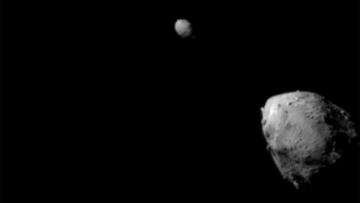The first image of the DART impact against the asteroid Dimorphos
The ATLAS system captured the impact of the NASA spacecraft against the asteroid. To find out if the course changed, we must wait for the data.

This morning the National Aeronautics and Space Administration (NASA) has taken an important step to avoid, in the future, possible asteroid impacts against our planet Earth. The US agency, after several months of preparation, managed to hit the DART spacecraft against the Dymorphos asteroid, which is in the Didymos system, early on Tuesday.
Around 1:14 am, the until now, first planetary defense mission ended. The success or not of it will be known as the weeks go by, when NASA experts check, with data, if the asteroid's orbit has changed slightly. Meanwhile, there are already images of the impact from outside the ship. They are the ones captured by the Asteroid Terrestrial Impact Alert System (ATLAS), based in Hawaii.
ATLAS observations of the DART spacecraft impact at Didymos! pic.twitter.com/26IKwB9VSo
— ATLAS Project (@fallingstarIfA) September 27, 2022
Through a sequence shared on social media, ATLAS reveals the moment when Didymos lights up considerably on impact, which happened eleven million kilometers, over 6.8 million miles, from Earth. A large layer of ejected material then shoots forward as a result of the DART spacecraft hitting the asteroid.
ATLAS, slope of the sky
This is an asteroid impact early warning system, which was developed by the University of Hawaii and funded by NASA. It is made up of four telescopes (two in Hawaii, one in Chile and one in South Africa), and between them they scan the sky several times every night in search of moving objects.
The US agency's DART mission is the first demonstration of a type of planet defense technology. It hit the asteroid Dymorphos after being sent into space ten months ago, in order to alter its trajectory for future missions given the possible threat of impacting the Earth.
Also see:
A success for the future
Related stories
“At its core, DART represents an unprecedented success for planetary defense, but it is also a mission of unity with a real benefit for all humanity,” said Bill Nelson, NASA administrator, after confirming the successful crashing of the ship against the asteroid. Now, the researchers expect that with the impact the orbit will be shortened by approximately 1%.
For Lindley Johnson, NASA Planetary Defense Officer, this milestone represents “a significant addition to the essential toolbox that we must have to protect the Earth from the devastating impact of an asteroid. We are no longer powerless to prevent these kinds of disasters.”


